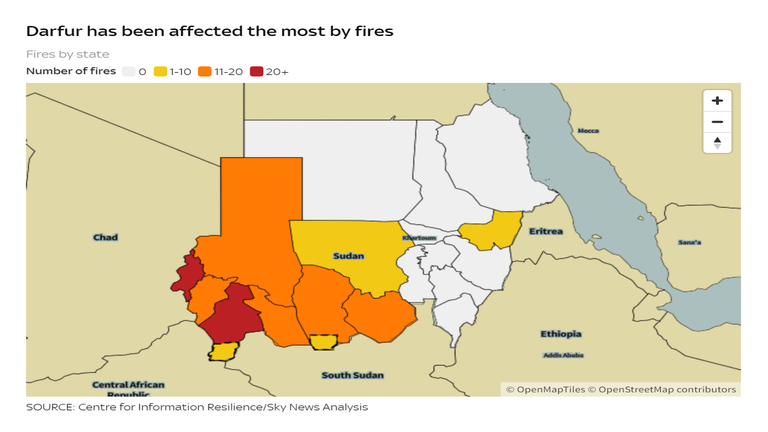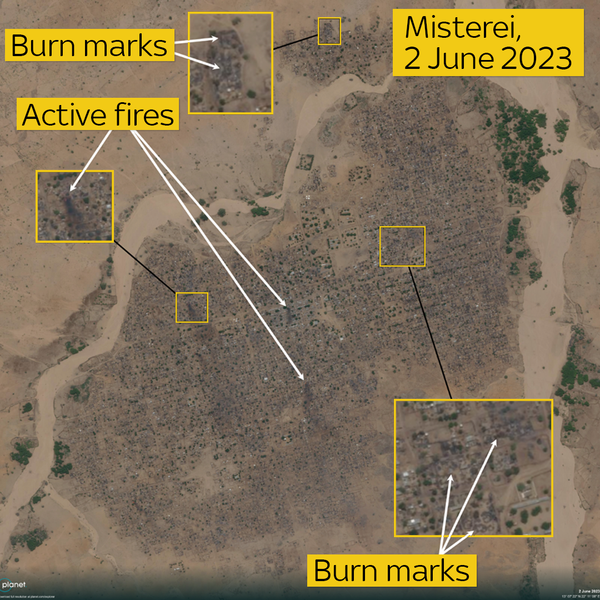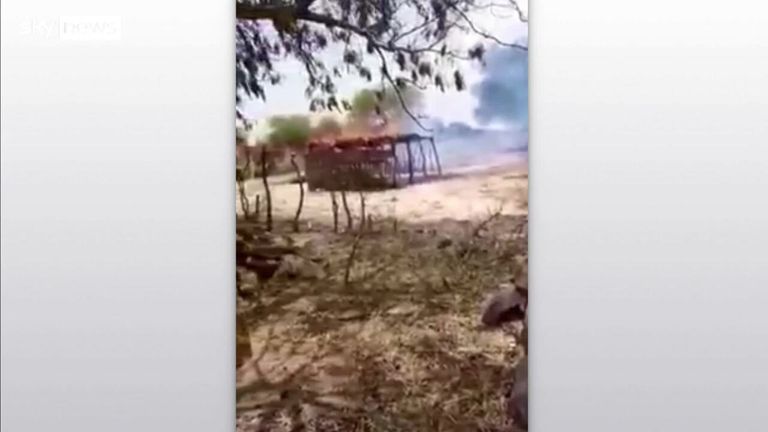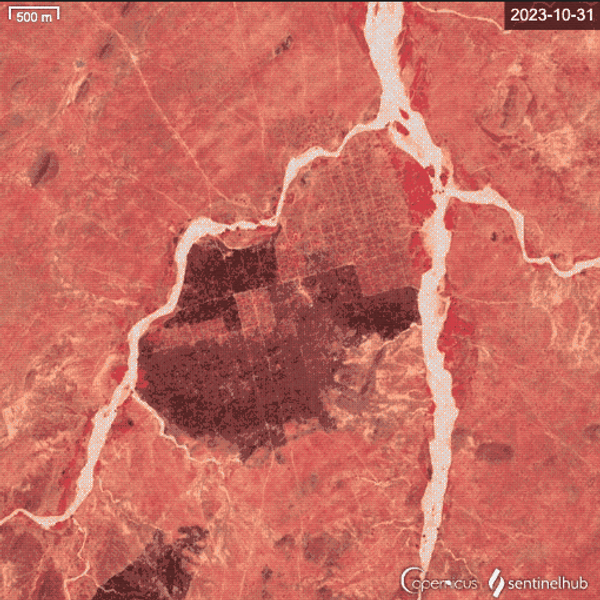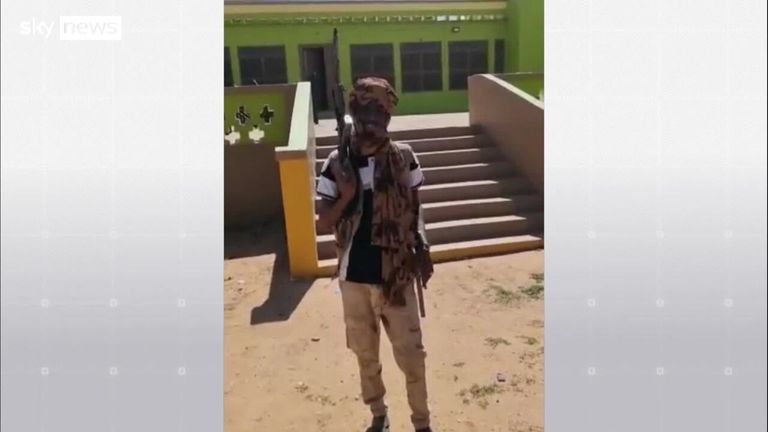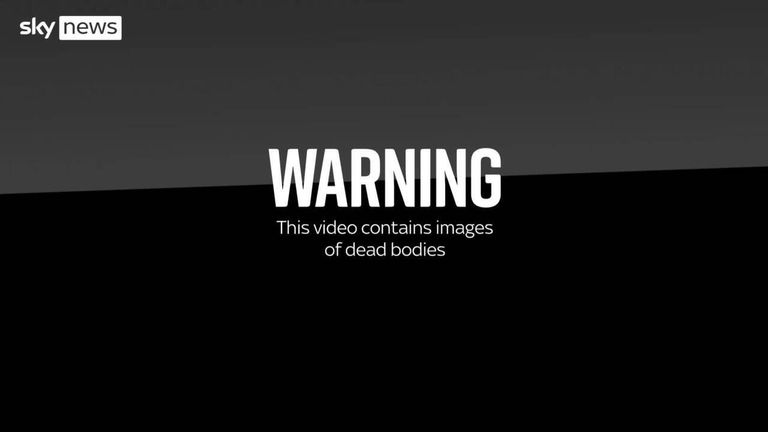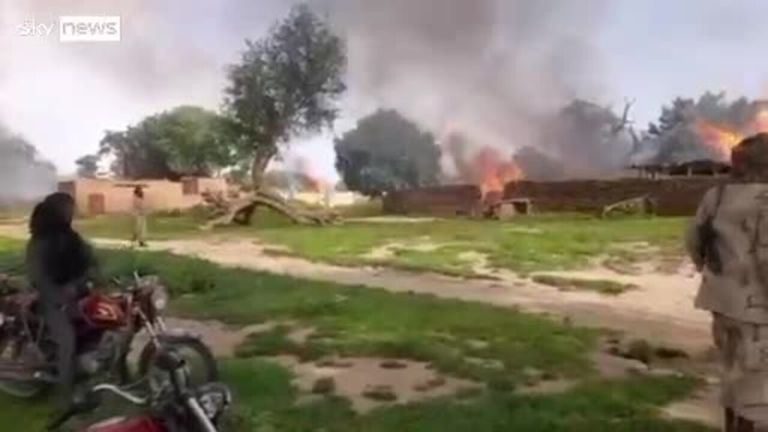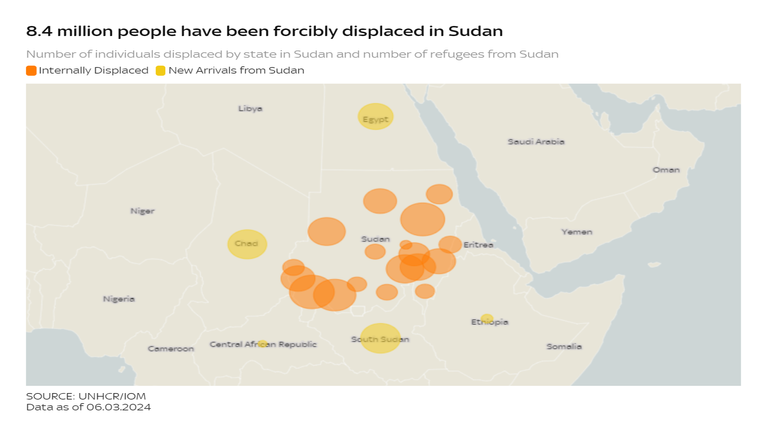New analysis, shared exclusively with Sky News, reveals 180 separate incidents of settlements in Sudan being set on fire, with 108 villages, towns and cities affected since the start of the war.
More than a quarter (27%) of the 108 settlements where burnings have been verified by the Centre for Information Resilience (CIR) have been targeted more than once since April 2023.
On 15 April, 2023, violent clashes erupted between the Sudanese Armed Forces (SAF) and the paramilitary Rapid Support Forces (RSF). Many of these fires have been attributed to the RSF and local level disputes.
The fires are another element of a war that has resulted in the forced displacement of millions of people and human rights abuses including more than 100 incidents of sexual violence observed by the UN.
Sir Nicholas Kay, a former British ambassador to Sudan, told Sky News the repeated fires may be a “deliberate attempt to… instil a great level of fear and extreme violence to subdue and remove the population”, and “a determined consistent effort to ensure people leave and don’t come back ever”.
US-Africa policy expert Cameron Hudson said the current RSF activity in Darfur is “ethnic cleansing”, including war crimes “that some people will call genocide” – reminiscent of the atrocities of 2003-05.
One Sudanese human rights worker who spoke anonymously to Sky News said he had been specifically targeted in an assassination attempt for his work doing things like providing water to people whose water sources had been burned and destroyed.
The Darfur region has experienced the most significant impact from the fires, with the majority of incidents taking place in the West Darfur state.
The highest number of fires took place in in El Geneina, the capital of West Darfur, along with the village of Misterei.
In one instance between 29 May and 2 June 2023, multiple fires were detected in Misterei, mainly inhabited by ethnic Masalit people, who have faced extensive violence from the RSF and allied Arab militias throughout the war.
Humans Rights Watch reported that the town came under attack on the morning of 28 May, when RSF and Arab militias allegedly launched an assault on the town.
Many were also injured with gunshot wounds and fled to Chad.
Satellite imagery of the town from 2 June shows both burn marks and active fires.
In the middle of the attack on Misterei, a video was recorded in the centre of town, in which burning and burned down houses are shown. The person filming accuses the Nuba people of killing and slaughtering and goes on to say “as you condemn, you will be condemned”, which roughly translates as “what goes around comes around”.
The video was shared in a RSF WhatsApp group and was located to the period between 30 May and 1 June 2023.
There was further fire damage in Misterei following a pattern of what appears to be strategic burnings of residential areas, where the town was burned in intervals of multiple days, between 6 October 2023 and 1 March 2024.
Between 11 and 31 October 2023, roughly 3,750 square metres (more than 60% of the town) was burnt in this manner.
“What the RSF is doing has felt very similar to what they did in a previous generation as the Janjaweed [a Sudanese Arab militia group that the RSF grew out of], in terms of who they’re targeting and how they are targeting them, ” explained Cameron Hudson, Senior Associate for the Africa Program at the Centre for Strategic and International Studies.
“One of the things we assessed at the time was that they were doing things like burning villages, poisoning water sources or destroying livestock to prevent people from ever returning.
“So, if they are doing that again, which is what this sounds like, then that is a very similar tactic to what we have seen before.
“There’s a profit motive here because there they are looting, they are taking valuables,” added Mr Hudson, who also served as the chief of staff to successive U.S. presidential special envoys for Sudan during the period of South Sudan’s separation from Sudan (2011) and the Darfur genocide (2003-2005).
As in Misterei, many of the burnings disproportionately affect the Masalit and other minority communities.
On 9 June 2023, a video was shared on X showing an RSF soldier outside the residence of the Sultan of the Masalit in El Geneina, making statements targeting the Masalit.
He says, “Dar [the house of] Masalit, only Arab. “Allah Akbar [x4].. Sultan Dar Masalit? .. There’s no more Dar Masalit, Dar Arab only.”
CIR geolocated the footage to the same day as potential related footage showing burning property and dead bodies in the streets only one block away from the Sultan’s residence.
Mr Hudson said: “Obviously, there has been ethnic cleansing by the RSF in Darfur going on recently, going on presently. There have been obviously war crimes committed and some people will call that genocide because it is targeting African tribal minorities in Darfur, so that is all reminiscent of an earlier period.”
Tribal conflicts
While the cases of El Geneina and Misterei show some of the violence and hatred incited by the RSF and its supporters, village fires have also been attributed to alleged local-level and inter-communal conflict.
“As we saw in the violence 20 years ago, there is a lot of very local level score settling and fighting going on between nomads and pastoralists between communities that have been in tension for a very long time and so within the context of this larger conflict, there is also a very local level conflict going on.
“I think the violence in Darfur is much more about local level, political, tribal and economic dynamics,” said Mr Hudson.
CIR also collected and verified multiple videos related to alleged clashes between Bani Halba and Al Salamat tribes in August and September 2023 in the Kubum and Mukjar localities, near the border of South and Central Darfur.
Various fighters on both sides appear in RSF uniforms.
Markundi, a town about 20 kilometres south from Kubum and inhabited largely by the Bani Halba, was attacked by what appears to be Al Salamat fighters on 7 September or 8 September.
Footage recorded by the Al Salamat people shows men in RSF uniforms surrounded by burning dwellings in an area nearby the Markundi market.
Continuing violence and displacement in Sudan
The findings add to atrocities already observed by the UN, including more than 100 incidents of sexual violence.
“It’s a messy war because there are many, many different factors. I heard so many Sudanese complaining and lamenting the fact that mercenaries from across the Sahel were fighting on the side of the RSF and were there essentially just to loot and unfortunately rape, in Khartoum in particular but in other parts of Sudan as well,” said Sir Nicholas Kay, former UK ambassador to Sudan, now Senior Advisor at Crisis Management Initiative.
More than 8.4 million people have been forcibly displaced since the start of the conflict in April 2023, equivalent to one in six people in Sudan.
“What we’ve also seen is that it’s not just settlements being targeted, but there is also frequent fires as at IDP camps, which would result in double displacement and people having to leave again because the areas that they’ve finally found refuge also turn out to be unsafe or are left unliveable,” said Anouk Theunissen, team leader for the Sudan Witness project at CIR.
More than 6.5 million are displaced within the country, with others fleeing to neighbours like Chad, South Sudan and Egypt.
This includes one human rights worker, Ibrahim (not his real name), who spoke with Sky News but requested to remain anonymous. He fled to Chad in June 2023 but witnessed burnings before he left.
“I was monitoring all kinds of violations committed by all parties of the conflict. I also provided potable water to citizens after the destruction and burning most of the water sources. These things made part of the conflict group target me. I survived an assassination attempt and the office was looted and burned.
“Secondly, because of my colour or race, the El Geneina War took on an ethnic manner, as people were killed on the basis of race or colour, especially after the killing of Wali Khamis and the defeat of the Masalit groups, where the Janjaweed took over the entire city and practiced the worst types of killing and looting.
“Because of all of that, I fled to Chad with great difficulty. I lost my homeland and my home, as it was completely looted and burned. I lost my job. I lost a number of my family members who have been killed, and I lost all that I have, money, documents, and other things.”
Despite the great scale of damage and humanitarian catastrophe, Sir Nicolas holds hope that people like Ibrahim may be able to return one day.
“I believe that those communities [targeted in the Darfur Genocide] proved to be resilient and as the conflict was ending and some people were being held to account for further violence and with the presence of the UN and African Union peacekeeping mission on the ground, communities did return, re-establish and consolidate themselves.
“So it’s happened before and again, it may happen after this round of violence and bloodletting. It would require, clearly, a determination by the international community and institutions to hold people to account but it would also require a future government of Sudan to also take seriously its responsibility to protect civilians and provide an environment in which all communities can live together.”
The Data and Forensics team is a multi-skilled unit dedicated to providing transparent journalism from Sky News. We gather, analyse and visualise data to tell data-driven stories. We combine traditional reporting skills with advanced analysis of satellite images, social media and other open source information. Through multimedia storytelling we aim to better explain the world while also showing how our journalism is done.

